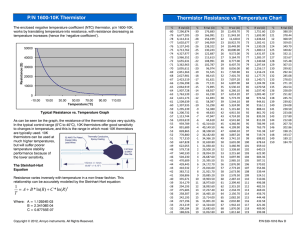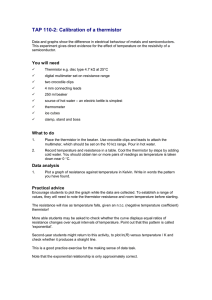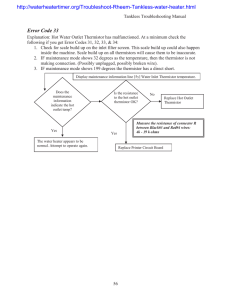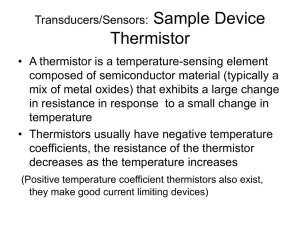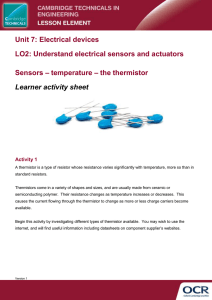OMEGA`s Precision Interchangeable Thermistors
advertisement
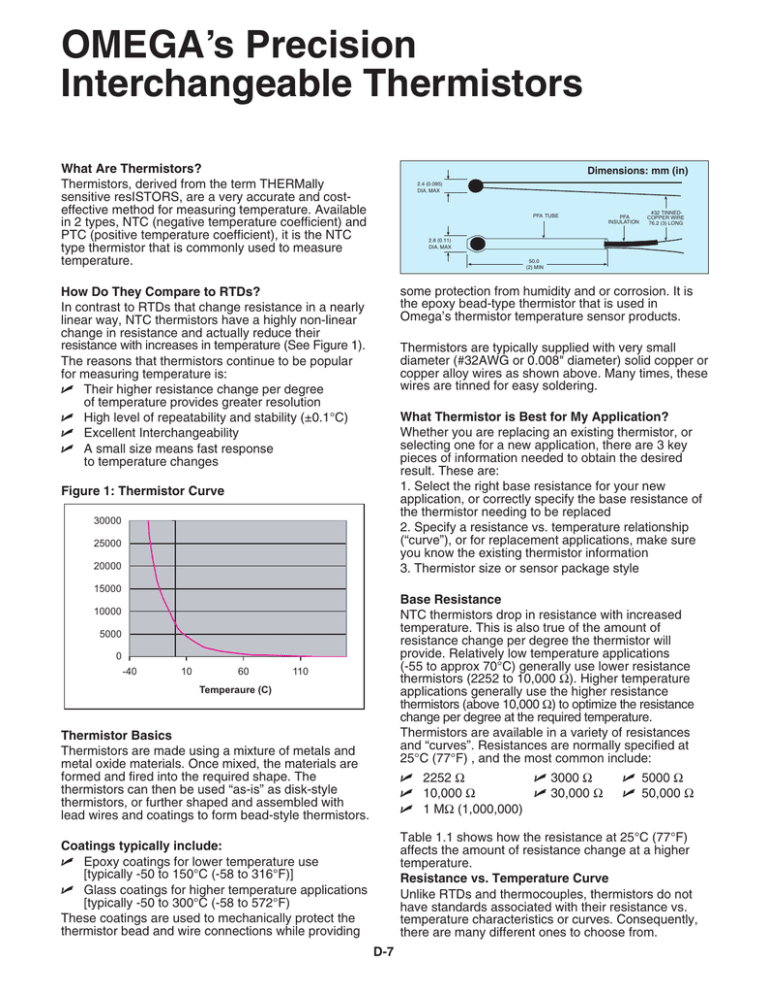
OMEGA’s Precision Interchangeable Thermistors What Are Thermistors? Thermistors, derived from the term THERMally sensitive resISTORS, are a very accurate and costeffective method for measuring temperature. Available in 2 types, NTC (negative temperature coefficient) and PTC (positive temperature coefficient), it is the NTC type thermistor that is commonly used to measure temperature. Dimensions: mm (in) 2.4 (0.095) DIA. MAX PFA TUBE PFA INSULATION #32 TINNEDCOPPER WIRE 76.2 (3) LONG 2.8 (0.11) DIA. MAX 50.0 (2) MIN some protection from humidity and or corrosion. It is the epoxy bead-type thermistor that is used in Omega’s thermistor temperature sensor products. How Do They Compare to RTDs? In contrast to RTDs that change resistance in a nearly linear way, NTC thermistors have a highly non-linear change in resistance and actually reduce their resistance with increases in temperature (See Figure 1). The reasons that thermistors continue to be popular for measuring temperature is: ⻬ Their higher resistance change per degree of temperature provides greater resolution ⻬ High level of repeatability and stability (±0.1°C) ⻬ Excellent Interchangeability ⻬ A small size means fast response to temperature changes Thermistors are typically supplied with very small diameter (#32AWG or 0.008" diameter) solid copper or copper alloy wires as shown above. Many times, these wires are tinned for easy soldering. What Thermistor is Best for My Application? Whether you are replacing an existing thermistor, or selecting one for a new application, there are 3 key pieces of information needed to obtain the desired result. These are: 1. Select the right base resistance for your new application, or correctly specify the base resistance of the thermistor needing to be replaced 2. Specify a resistance vs. temperature relationship (“curve”), or for replacement applications, make sure you know the existing thermistor information 3. Thermistor size or sensor package style Figure 1: Thermistor Curve 30000 25000 20000 15000 Base Resistance NTC thermistors drop in resistance with increased temperature. This is also true of the amount of resistance change per degree the thermistor will provide. Relatively low temperature applications (-55 to approx 70°C) generally use lower resistance thermistors (2252 to 10,000 Ω). Higher temperature applications generally use the higher resistance thermistors (above 10,000 Ω) to optimize the resistance change per degree at the required temperature. Thermistors are available in a variety of resistances and “curves”. Resistances are normally specified at 25°C (77°F) , and the most common include: 10000 5000 0 -40 10 60 110 Temperaure (C) Thermistor Basics Thermistors are made using a mixture of metals and metal oxide materials. Once mixed, the materials are formed and fired into the required shape. The thermistors can then be used “as-is” as disk-style thermistors, or further shaped and assembled with lead wires and coatings to form bead-style thermistors. ⻬ 2252 Ω ⻬ 3000 Ω ⻬ 10,000 Ω ⻬ 30,000 Ω ⻬ 1 MΩ (1,000,000) ⻬ 5000 Ω ⻬ 50,000 Ω Table 1.1 shows how the resistance at 25°C (77°F) affects the amount of resistance change at a higher temperature. Resistance vs. Temperature Curve Unlike RTDs and thermocouples, thermistors do not have standards associated with their resistance vs. temperature characteristics or curves. Consequently, there are many different ones to choose from. Coatings typically include: ⻬ Epoxy coatings for lower temperature use [typically -50 to 150°C (-58 to 316°F)] ⻬ Glass coatings for higher temperature applications [typically -50 to 300°C (-58 to 572°F) These coatings are used to mechanically protect the thermistor bead and wire connections while providing D-7 Each thermistor material provides a different resistance vs. temperature “curve”. Some materials provide better stability while others have higher resistances so they can be fabricated into larger or smaller thermistors. Table 1.1 Thermistor Model No. 44004 44005 44007 44006 44008 Resistance @ 25°C (77°F) 2252 Ω 3000 Ω 5000 Ω 10000 Ω 30000 Ω Resistance Change per °C at 50°C 30.7 Ω 42 Ω 70 Ω 140 Ω 420 Ω D ON-403-PP, $70. See page D-19 for more information. Many manufactures list a Beta () constant between 2 temperatures (Example: 0/50 = 3890). This, along with the resistance at 25°C (77°F) can be used to identify a specific thermistor curve. See pages Z-236 and Z-237 for Omega’s thermistor curves. Liquid Immersion Measurement When exposed to liquids, thermistors need to be protected from corrosion as well as positioned into the fluid so it will come to the needed temperature. This is typically achieved using closed ended tubes and specially designed housings. Care must be taken to make sure that there is a good thermal path to the thermistor, and that thermal mass is as small as possible. Size or Sensor Package Style Once the right resistance and “curve” are established, the user should consider how the thermistor will be used. When selecting the right size or packaging for the sensor, it helps to remember that like any other sensor, a thermistor only measures its own temperature. Thermistor beads are generally not designed for direct immersion into a process. They are small devices that change temperature very quickly since the only thing between them and the environment is a thin coating of epoxy. At Omega, offer a comprehensive line of sensors that protect the thermistor while allowing it to be used in a wide variety of applications. Below are a sampling of some of these styles. ON-909-44004-40, $49. See page D-20 for more information. Surface Sensing A simple but effective sensor design for monitoring surface temperature is the ON-409 attachable surface sensor. This design includes a thin, round metal stamping into which the thermistor is epoxied. The metal stamping can then be attached to a surface using an epoxy or other method to measure surface temperature. ON-950, $43. See page D-18 for more information. There are many thermistor options presented in the following pages. If you don’t find the right sensor for your application, or have questions concerning your application, please give our Customer Service Engineers a call. Additional information can also be found on our Website omega.com/tmistor. General Purpose General purpose sensor designs are those that can be adapted to a wide variety of uses. Ranging from electronic equipment to structures, processes and design and reliability testing applications, these sensors are easy to install and monitor. The Omega ON-950 is an example of this type of construction. A small SST housing with #8-32 threaded stud can be installed into any #8-32 threaded hole, taking up a very small amount of space. See Section I D-8 One Omega Drive | Stamford, CT 06907 | 1-888-TC-OMEGA (1-888-826-6342) | info@omega.com www.omega.com UNITED KINGDOM www. omega.co.uk Manchester, England 0800-488-488 UNITED STATES www.omega.com 1-800-TC-OMEGA Stamford, CT. FRANCE www.omega.fr Guyancourt, France 088-466-342 CANADA www.omega.ca Laval(Quebec) 1-800-TC-OMEGA CZECH REPUBLIC www.omegaeng.cz Karviná, Czech Republic 596-311-899 GERMANY www.omega.de Deckenpfronn, Germany 0800-8266342 BENELUX www.omega.nl Amstelveen, NL 0800-099-33-44 More than 100,000 Products Available! Temperature Calibrators, Connectors, General Test and Measurement Instruments, Glass Bulb Thermometers, Handheld Instruments for Temperature Measurement, Ice Point References, Indicating Labels, Crayons, Cements and Lacquers, Infrared Temperature Measurement Instruments, Recorders Relative Humidity Measurement Instruments, RTD Probes, Elements and Assemblies, Temperature & Process Meters, Timers and Counters, Temperature and Process Controllers and Power Switching Devices, Thermistor Elements, Probes and Assemblies,Thermocouples Thermowells and Head and Well Assemblies, Transmitters, Wire Flow and Level Air Velocity Indicators, Doppler Flowmeters, Level Measurement, Magnetic Flowmeters, Mass Flowmeters, Pitot Tubes, Pumps, Rotameters, Turbine and Paddle Wheel Flowmeters, Ultrasonic Flowmeters, Valves, Variable Area Flowmeters, Vortex Shedding Flowmeters pH and Conductivity Conductivity Instrumentation, Dissolved Oxygen Instrumentation, Environmental Instrumentation, pH Electrodes and Instruments, Water and Soil Analysis Instrumentation Data Acquisition Auto-Dialers and Alarm Monitoring Systems, Communication Products and Converters, Data Acquisition and Analysis Software, Data Loggers Plug-in Cards, Signal Conditioners, USB, RS232, RS485 and Parallel Port Data Acquisition Systems, Wireless Transmitters and Receivers Pressure, Strain and Force Displacement Transducers, Dynamic Measurement Force Sensors, Instrumentation for Pressure and Strain Measurements, Load Cells, Pressure Gauges, Pressure Reference Section, Pressure Switches, Pressure Transducers, Proximity Transducers, Regulators, Strain Gages, Torque Transducers, Valves Heaters Band Heaters, Cartridge Heaters, Circulation Heaters, Comfort Heaters, Controllers, Meters and Switching Devices, Flexible Heaters, General Test and Measurement Instruments, Heater Hook-up Wire, Heating Cable Systems, Immersion Heaters, Process Air and Duct, Heaters, Radiant Heaters, Strip Heaters, Tubular Heaters click here to go to the omega.com home page EPG05
